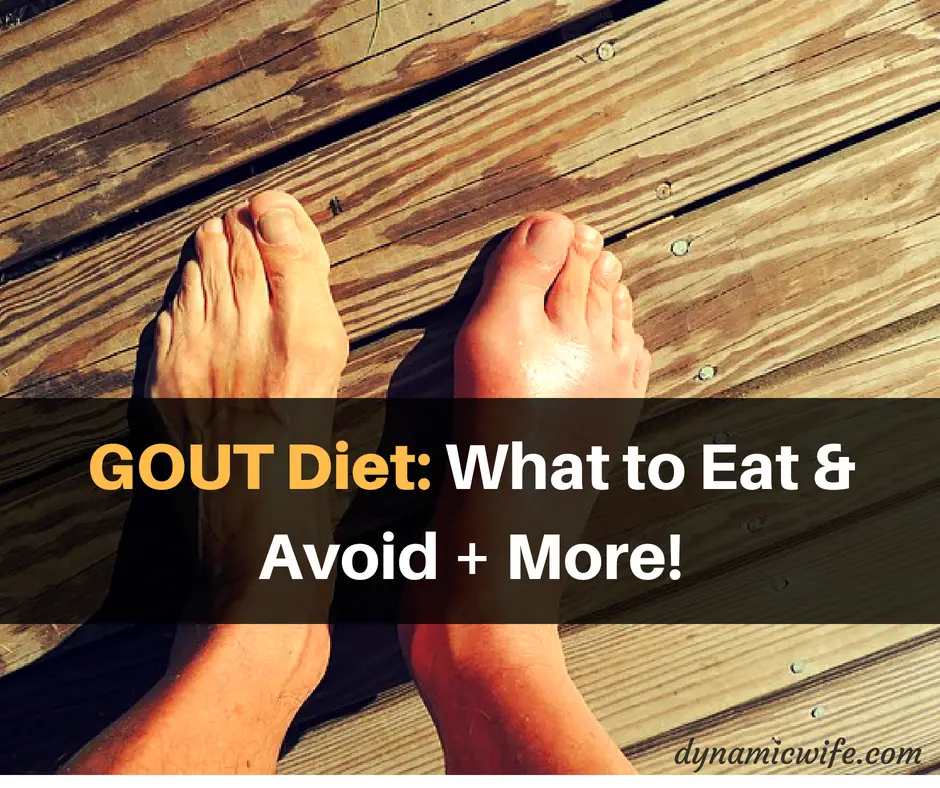This guide explores the gout diet in detail so you can learn about what to eat and the foods to avoid when you’re on it.
SEE ALSO: Best remedy for legs cramp
What Is Gout?
Gout is an incredibly painful chronic inflammatory disease that causes a buildup of uric acid crystals between the joints [1].
Though it tends to afflict the large joint of the big toe most often, symptoms can also occur in your feet, ankles, knees, hands, and wrists.
Typically, affliction with gout is characterized by sudden intense pain, redness, heat, swelling, and tenderness in the joint area.
Despite the pain, the most difficult part of dealing with gout is attempting to find relief and finding a method of relief that doesn’t come with additional side effects, so that’s what we’re going to focus on in this article – natural gout relief.
Gout is a common condition that affects an estimated 5.1 million Americans. Traditionally, gout has been thought of as a disease of the wealthy who dined on fatty meats, wines, and rich dairy products.
Hippocrates described gout as “the disease of kings” because it was associated with such a rich diet.
Gout is an arthritis-like metabolic disorder that is a result of an increase in uric acid concentration from eating certain foods.
The uric acid crystallizes and deposits in the joints, tendons, kidneys and other tissues, causing inflammation, swelling, and damage [2]. The uric acid is a byproduct of the breakdown of purines in food.
Typically, those who suffer from gout are obese, prone to high blood pressure and diabetes and they may have a history of poor cardiovascular health.
The Gout Cycle
Gout is cyclical just like every other inflammatory condition. It originates with a “glitch” in your body’s natural immune response and circulates out of control from there. In the case of gout, the culprit that causes the beginning of the disease is uric acid.
A buildup of uric acid can be the result of eating high purine food sources, such as meat and fish, excessive drinking and sometimes even result from prescribed diuretics [3].
It’s more common in men than women. Once the uric acid levels in the body are elevated, it causes a drop in the natural pH of the body, which allows crystals to form around the joints.
When the crystals start to form, that’s seen as a “threat” by the immune system and white blood cells are called in to clean up the mess.
As the white blood cells try to attack the crystals, they are popped causing more protein in the bloodstream, which results in the immune system sending more white blood cells to the area and results in inflammation and pain.
From there, the process continues to spiral out.
Breaking the Gout Cycle
Relief from gout only really comes from breaking the gout cycle. Traditionally, modern medicine takes a three-step approach to deal with gout.
- Medication to deal with the pain
- Medication to reduce the Inflammation
- Medication to get rid of the excess uric acid
There’s nothing wrong with this approach but each medication can come its set of side effects as well.
That’s why it’s important to seek out a natural remedy for gout as well as understand how gout occurs and how you can prevent it from returning in the future.
Gout Symptoms
A gout attack can be characterized by intense pain in one or more joints that is described as feeling like a dislocation.
The first joint in the big toe is the most common one affected by 90% of those who have gout. Joints with gout are swollen and red.
Symptoms of gout may vary. Most gout attacks usually start out at night. Once the first symptom is experienced from a gout attack, uric acid has already built up in the blood and the deposits may be forming in one or more of your joints.
They usually come on after overeating, drinking too much alcohol, some kind of an injury, and even certain medications or surgical procedures [4].
Besides the big toe, other common sites for gout flare-ups are the ankle, heel, knee, and the wrist. In some cases, the back, hip, or shoulder can be affected by gout.
What Causes Gout?
Gout is a condition that is closely related to the affected individual’s diet.
Some common causes of gout include obesity, stress, enzyme deficiency, chemotherapy, kidney disease, psoriasis, cytotoxic medications, diuretics, and heart failure [5].
Genetics also play a role in who gets gout. A family history of gout is reported in 18% of those who suffer from this painful condition.
However, it is possible to never have an attack of gout and have elevated levels of serum uric acid.
Gout Diet
What To Eat And What To Avoid To Keep Gout At Bay
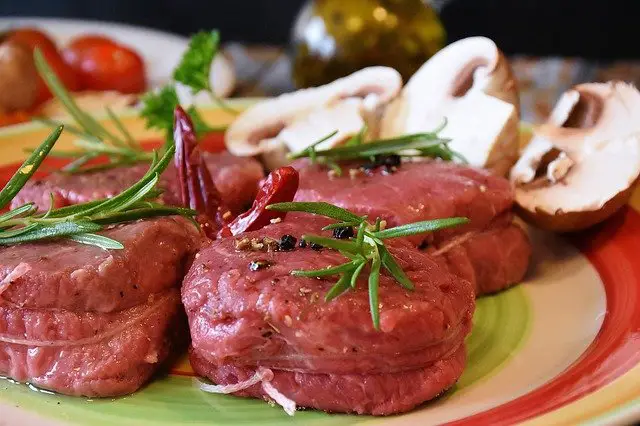
Before going on drugs to treat gout, modifying your diet is the preferable approach.
The first change that should be made is to avoid purine-rich foods such as anchovies, meat gravies and broths, organ meats, lunch meats, asparagus, herring, sardines, mussels, and mushrooms.
Other foods to avoid are white flour, sugar, and processed foods. Also try to limit dried beans, cauliflower, fish, lentils, oatmeal, poultry, and saturated fats.
Alcohol consumptions must be stopped as it increases the production of uric acid and restricts its elimination by the kidneys.
Try to eat fresh foods like raw fruits and veggies. Grains, seeds, nuts, and high fiber foods will help too. It is also a good idea to drink plenty of water to aid in the elimination of uric acid through the urine.
Supplements for Gout
The following supplements may help to ease the suffering, pain, and inflammation associated with Gout.
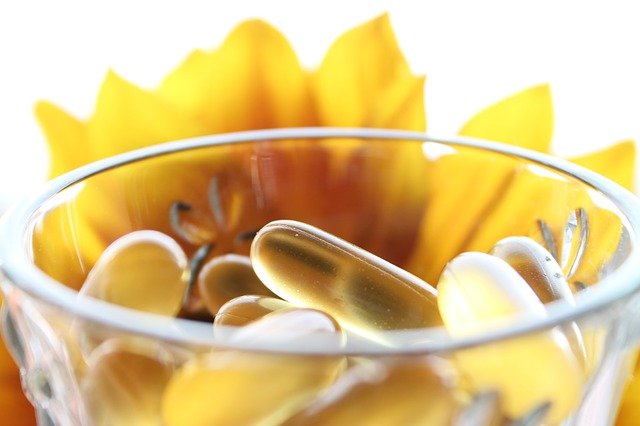
Alfalfa Tablets
Alfalfa is a rich source of minerals and other nutrients that help reduce serum uric acid. Take 2-3 grams per day during a gout flare up and one gram per day as a preventative.
Vitamin C With Bioflavonoids
Vitamin C with Bioflavonoids helps to lower serum uric acids levels by increasing renal excretion. 3-4,000 mg a day in divided doses is recommended.
Celery Seed
Celery seed helps to relieve gout by elimination uric acid from the body. Celery seeds also contain about 20 different anti-inflammatory agents.
Omega 3 Fatty Acids
The EPA in fish oil helps to inhibit the production of the inflammatory agents produced from gout.
Red Tart Cherry Juice
Red tart cherry juice contains a compound called anthocyanins, which are the pigments that give cherries their bright red color and are also believed to be the key to helping the body relieve inflammation.
This has to lead to Red Tart Cherries is one of the safest, most natural, and popular treatments for gout.
Gout Diet: Food To Avoid
The purines in food are the culprits, so you need to concentrate on foods that are low in purines. Meat is something that you should be eating in small portions.
Organ meats like brains, kidneys, and liver are best eliminated from your diet entirely.
It’s also good to avoid gravy and meat extracts. Beef, pork, and lamb should be eaten in six-ounce portions or less.
Forget you ever liked bacon. Chicken isn’t bad, but limit your use of duck, goose, and…yep…turkey.
Seafood isn’t your best bet either, so it will be high on your list of gout foods to avoid. But shrimp, crab, and lobster aren’t too bad…in small portions.
However, your list of no-nos should include caviar, sardines, anchovies, mussels, scallops, herring, mackerel, and trout [6].
Even some fruits and vegetables are bad eating for gout victims. Believe it or not, the smaller the tomato, the higher the purines.
Tomatoes should be eaten in moderation, and a beefsteak tomato is better for you than a cherry tomato, a grape tomato, and even a plum tomato!
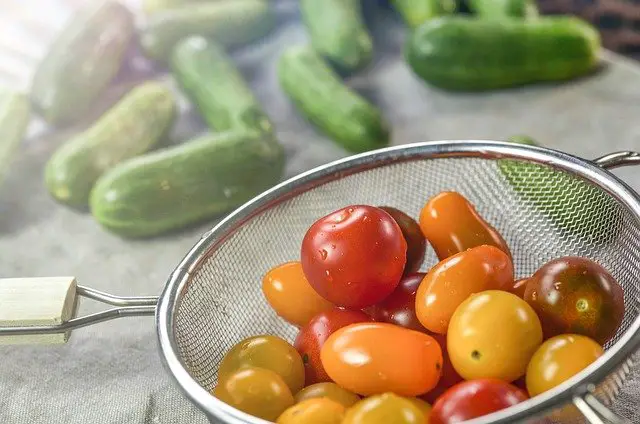
Among gout foods to avoid or at least eat sparingly, are the legumes, such as dried beans, lentils, and peas. Spinach and asparagus can also be a problem. And mushrooms can really get your toes radiating.
Oatmeal isn’t great for you either, in terms of purines. But it is a healthful food, so use common sense. Eat small portions of it, and avoid it when you are having pain.
Bread with high yeast content is also problematic. Which brings up another unpopular fact. Beer is a definite no-no, with its high yeast content. Eliminating all alcohol is a good idea, but at least temper your use of other liquors and wines.
Knowing the gout foods to avoid is a big step in the right direction. However, there is more you can do. Exercise daily and drink plenty of water to help dilute the uric acid. You will be glad you did.
Did you know that gout is the only form of arthritis that can be relieved by what you eat?
Therefore, if you have had a gout attack or gout runs in your family it is wise to understand which foods to avoid with gout to stop any of the nasty symptoms.
Gout is tremendously painful and it’s on the increase. It used to be an affliction that made the lives of the rich a misery because of their rich diet and high alcohol consumption.
Nowadays, since our societies have gotten wealthier we are leaving ourselves wide open for gout due to our reliance on processed foods, red meats, and increased alcohol consumption.
Gout Foods: Avoiding Purines

Gout is caused by a condition known as hyperuricemia [7]. This is when the uric acid in your blood is abnormally high. Although not dangerous in itself, hyperuricemia can lead to the development of gout.
When uric acid levels reach saturation point in the bloodstream, small deposits are made in the spaces and connective tissues of the joints.
These deposits crystallize, causing sharp, jagged needles that are the reason behind the swift swelling, redness, and pain characterized by a gout attack.
Hyperuricemia is caused by an increased production of uric acid in the blood or the kidneys being unable to process uric acid effectively. This can be for hereditary reasons or by eating too many purine-rich foods, drinking alcohol heavily and becoming dehydrated.
Gout is caused by excess uric acid in the body. Uric acid results from the breakdown of purines. Purines are part of all human tissue and found in many foods.
The excess can be caused by either an over-production of uric acid by the body or the under-elimination of uric acid by the kidneys.
Also, the ingestion of foods high in purines can raise uric acid levels in the blood and precipitate gout attacks in some people.
It’s known as one of the most painful rheumatic conditions and is estimated that 840 out of 100,000 people suffering from all kinds of arthritis have gout pain.
Although it usually affects the big toe, it can also affect your ankles, heels, knees, wrists, fingers, or elbows. The definitive diagnosis for gout depends on finding uric acid crystals in the joint fluid during an acute gout attack.
Traditionally affecting men, more than women, bouts of gout are increasing for both groups.
Purine is a natural compound found in a lot of our food, particularly animal proteins. When ingested the body goes to work, breaking the purine down and producing uric acid as a result.
Purine is found in high levels in processed foods and some alcohol, beer in particular.
It stands to reason that having a diet high in animal and purine-rich foods, along with drinking excessive amounts of alcohol can lead to gout, especially if it is a condition that runs in the family.
One of the first steps you can take to battle gout is to drink water and stay hydrated. By doing so, you’ll be making it easier for the kidneys to deal with any excess uric acid in your blood.
However, to really go about lowering uric acid levels you need to look at your diet and make some amendments, as there are a few foods to avoid with gout.
Among the worst offenders are:
- Most meats
- Offal
- Meat extracts
- Game Meats
- Processed meat
- Gravy
- yeast extracts
- Mackerel
- Sardines
- Scallops
- Anchovies
- Herring
- Chocolate
- Caffeinated beverages
- Legumes ie. peas, beans & lentils
- Asparagus
- Mushrooms
These foods are very high in purine and should be avoided, especially during a gout flare-up.
Once gout symptoms are under control, small volumes of these foods can be eaten, however, it must only be in moderation or you will be running a risk of experiencing further gout attacks.
The best way to manage your gout through diet is to look at changing the foods you eat as a lifestyle choice rather than a diet.
That way you bypass the feelings of ‘missing out’ and your new food choices become a habit.
High Purine Foods to Avoid
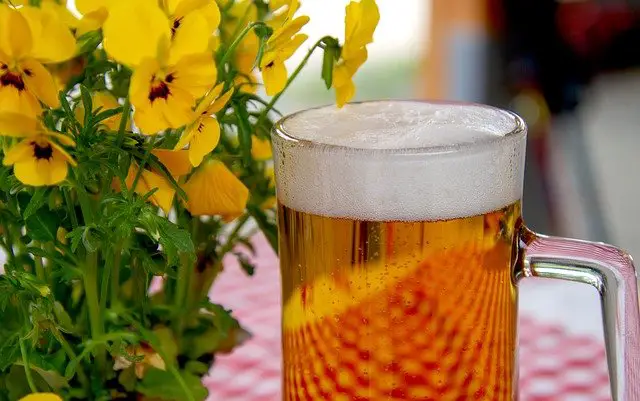
Beer, anchovies, organ meat (brains, kidney, liver, sweetbreads), game meats, gravies, yeast, meat extracts, sardines, herring, mackerel, scallops.
Medium Purine Foods
These are foods you can eat in moderation.
Fresh and saltwater fish, shellfish, eel, meat, poultry, meat soups and broth, asparagus, mushrooms, cauliflower, spinach, legumes, oatmeal, bran, wheat germ, whole-grain bread and cereals, eggs.
Did You Know?
Coffee is low in purines.
Low Purine Foods
No Restriction
Bread and cereals (low-fiber, white flour, or refined grain types), nuts, peanut butter. Vegetables not high in purines, soups – cream style or vegetable without meat extract, coffee, tea, fruit juices, soft drinks, gelatin, sugar, low-fat cheeses.
Gout Treatment and Prevention
Gout cannot really be cured, but you can reduce the severity, the number of attacks that you have, and in some cases, actually, prevent the attacks from occurring.
But to do so, you have to strictly follow the gout treatment and prevention plan set out for you by your doctor.
It only takes one shocking attack waking you up in the middle of the night for you to start looking into getting help, but, because it is a lifetime commitment, it isn’t always easy to stick with the program.
To make it even more difficult, you can have ten attacks in a month, and not have another for a year, which, of course, lets you fool yourself into thinking you don’t have gout anymore.
If your family has any history at all of having gout, you could start practicing gout treatments and prevention before you ever have that first attack.
Actually, you won’t need the treatment until you have that first attack, but prevention, in the way of a smart, low purine diet should become part of your daily life.
As mentioned earlier, most meats, including wild game and poultry are high in purines. So is mostly seafood.
And some kinds of fish aren’t good either…anchovies, sardines, salmon, mackerel, herring…the list goes on.
All the things mentioned above have something in common, and that is fat. You need to avoid fatty food, rich foods, sugar, yeast, caffeine, and white flour.
Replace them with raw vegetables and fresh fruits, rice, and whole wheat bread. One more thing…for gout treatment and prevention, trade soda for unsweetened juices and water.
And as repeated throughout this post, alcohol is a no-no too…, especially beer. As far as treatment goes, anti-inflammatories, steroids, and colchicine will reduce pain and swelling.
To aid in reducing the amount of uric acid in your system, in addition to your gout diet, your doctor may prescribe Allopurinol.
Uric acid is the bad boy that needs to be controlled when you have gout. When too much of it builds up in your body, it forms sharp crystals that lodge in the joints of your extremities.
Anyone who has suffered from the shocking, sharp pains that attack with no warning, is willing to try just about anything to stop them. Gout treatment foods are the answer.
The only problem is that you need to go on a gout diet before you have an attack and stay on it.
It is the purine in foods that we eat that is converted to uric acid in your body. If you have gout, changing your diet to one that is low in purines should lower the incidence of attacks and the severity of them.
In addition, by adding natural foods that characteristically reduce swelling and inflammation to your diet, you will be well on the way to controlling this nasty form of arthritis.
Gout Friendly Foods
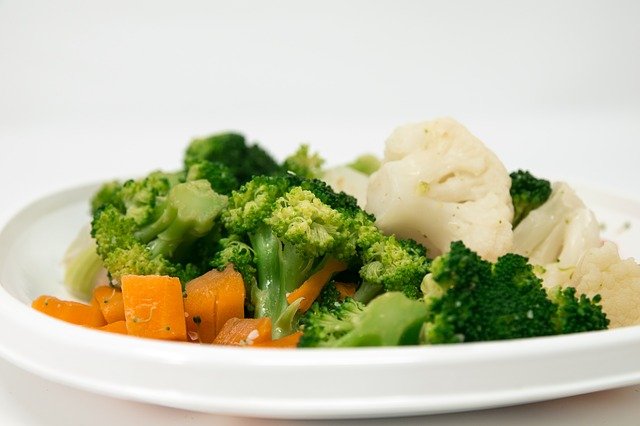
Vegetable protein, and the high fiber that is found in raw vegetables…especially leafy greens and broccoli…are foods that you should consume in large quantities daily.
Other gout treatment foods are dairy products, though you should choose low fat or fat-free when buying milk, cottage cheese, sour cream, cream cheese, and any other cheeses.
There are actually some veggies that you should avoid eating. Mushrooms, asparagus, and tomatoes are just a few of them. Actually, the large, beefsteak tomatoes are fine, but for some reason, the tiny tomatoes seem to cause problems. You should also avoid peas and dried beans.
Fruit should be eaten fresh. Citrus fruits are high in vitamin C, and that is going to help. So are berries…particularly strawberries and blueberries.
Cherries would be a good thing to eat every day, either fresh, dried, or in the form of juice. Bananas and apples are an excellent choice.
Along with your gout treatment foods, drink plenty of water, and you will soon see a reduction in your pain.
Gout Home Remedies
If you are looking for a cheap gout relief, try a homemade black bean broth. Black beans are a natural remedy that is very rich in anthocyanins, the same ones that are found in cherries and other dark berries.
All you have to do is simmer seven ounces of black beans in two liters of water. Start timing after it has come to a boil and then reduce the heat and simmer for ninety minutes.
Strain out the broth, and toss the beans. After it cools, drink one-fourth of the liquid. You can drink it daily as a preventative measure, or at the first sign of a gout attack.
Certain bacteria consume uric acid before it can cause a problem. If you have gout, it is an indication that there is an imbalance in the intestines.
Eating lots of raw vegetables and fruits (more fruits than veggies), and eating some yogurt can help increase good bacteria in your body. Cultured cabbage juice is really good, too.
But at the same time, you need to be avoiding the foods that exacerbate the problem…like yeast, alcohol (especially beer, since it contains yeast), fatty meats, seafood, and mushrooms, to name a few.
For a topical treatment, you can rub rosemary oil in the inflamed area, avoiding any broken skin. If the oil itself seems to irritate the area, dilute it by adding some olive oil to it.
The bromelain in pineapple reduces inflammation, allowing blood to get to the area and easing the joint much faster. Burdock is a plant high in bromelain, but it is grown mostly in Japan and Europe, making it a bit pricier than pineapple.
Are you on a gout diet?
Please share your experience and tips in the comments below.
